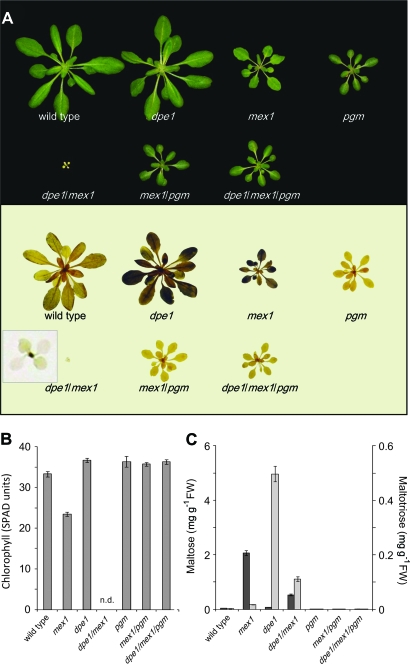Figure 2.
Modulation of the Chlorotic and Malto-Oligosaccharide-Accumulating Phenotypes of mex1 by Introducing dpe1 and pgm Mutations.
(A) Photographs of plants (upper panel) grown in a 12-h photoperiod. All plants were 5 weeks old. Note the extreme chlorotic dwarf phenotype of dpe1/mex1 double mutants and that blocking starch synthesis through introduction of the pgm mutation rescues chlorosis of both mex1 and dpe1/mex1. Harvesting plants at the end of the night and staining them for the presence of starch with iodine (lower panel) reveals that the starch-excess phenotype visible in dpe1 and mex1 is lost in the dpe1/mex1 double mutant. Inset shows an enlargement of a stained dpe1/mex1 plant. Note the dark-staining youngest leaves (see also Supplemental Figure 1D).
(B) Chlorophyll content of mature leaves of the wild-type and the mutants shown in (A), measured using a SPAD chlorophyll meter and expressed on a leaf area basis. Each value is the mean ± SE of nine replicate measurements on different leaves from at least three individual plants. n.d., not determined (leaves were too small for accurate analysis). The chlorophyll content of mex1 is significantly lower than the wild-type but that of mex1/pgm is not significantly different from pgm (student's t-test, p ≤ 0.5).
(C) Maltose (dark bars) and maltotriose contents (light bars) at the end of the night. Values are the mean ± SE of three to five replicate samples, each comprising a single rosette extracted using ethanol (see Methods). Note the 10-fold difference in scale of the two y-axes.

